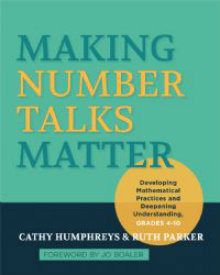Get Kids Thinking with Talks about Math
Making Number Talks Matter: Developing Mathematical Practices and Deepening Understanding Grades 4-10
By Cathy Humphreys and Ruth Parker
(Stenhouse Publishing, 2015 – Learn more)

Making Number Talks Matter is an excellent read for all math teachers. The book both tells how to do math talks and why these talks are an important means of helping all students become confident mathematical thinkers.
The book is organized into chapters by operation (with one additional chapter on fractions, decimals and percent), making it easy for teachers to find quickly what they need. The final two chapters cover various topics, namely how to foster deeper math investigations and how to manage problems that teachers are likely to encounter using math talks in the classroom.
 Rethinking math instruction
Rethinking math instruction
The book is about math talks but also includes much discussion of how teachers need to rethink the way they teach math. Many of students’ problems in math come from the way in which the subject is often explained – not because of problems with the mathematical content itself. The authors are quick to note that teachers were taught to teach math in a way that focuses too much attention on how to use algorithms and not enough on reasoning and sense-making.
For those who are not familiar with math talks the book provides detailed descriptions and encouragement to start the practice of having mathematical conversations on a daily basis in every classroom. The authors offer detailed examples of math talks, making them easy to replicate. Throughout the book the links between math talks and the Mathematical Practices included in the Common Core are highlighted, so teachers using CCSS-based standards will find this reference particularly helpful.
Seeing math talks in action
Humphreys and Parker include examples of problems that can be used with all operations (subtraction, addition, multiplication and division) as well as fractions, decimals, percent and negative numbers. Short examples of math talks used in real classrooms round out the how-to explanations. Although the descriptions are complete, the authors remind readers that there are no predictable outcomes with math talks because the talks focus on students’ understanding and reasoning which may be surprising, hard to understand, and different from what teachers might expect.
Although math talks are designed to be short, only about 15 minutes per class per day, they are anything but short of serious math content. Nor does their short nature mean less planning for the teacher. The authors provide guidance on how to choose the right problem for the class, what and how to question students, and how to record what students are saying.
Preview Number Talks at the publisher’s website
Catching students’ thoughts
For recording of students’ reasoning there are examples of how to use an open number line and rectangular arrays to help students visualize the math problem. Teachers are encouraged to use multiple types of representations of students’ thinking to expose them to different ways that math is represented (such as geometrically and algebraically).
Throughout the book there is an emphasis on teachers’ listening and understanding what the students have to say, without putting words into the students’ mouths. Humphreys and Parker encourage teachers not to say too much as this will discourage students from engaging with the math.
Meeting the challenges
The book concludes by highlighting the problems that teachers are likely to encounter in the classroom and offers suggestions for overcoming them. Many of the problems are related to the way teachers generally teach math as well as to students’ initial attitudes to math talks and math learning in general.
Humphreys and Parker have done an excellent job explaining both the how and the why behind math talks. Whether you are introducing math talks to your class or are an experienced had at dialoging about math, I am confident that this book will help you create even better mathematical thinkers in your classroom.
Jennifer Underwood, an elementary school teacher and former diplomat, taught fourth grade in an international school in Seoul, South Korea where she used math talks. She has also worked as a high school librarian in Geneva, Switzerland. She recently moved to Virginia where she is looking forward to developing mathematical practices and deepening understanding in her next classroom.































